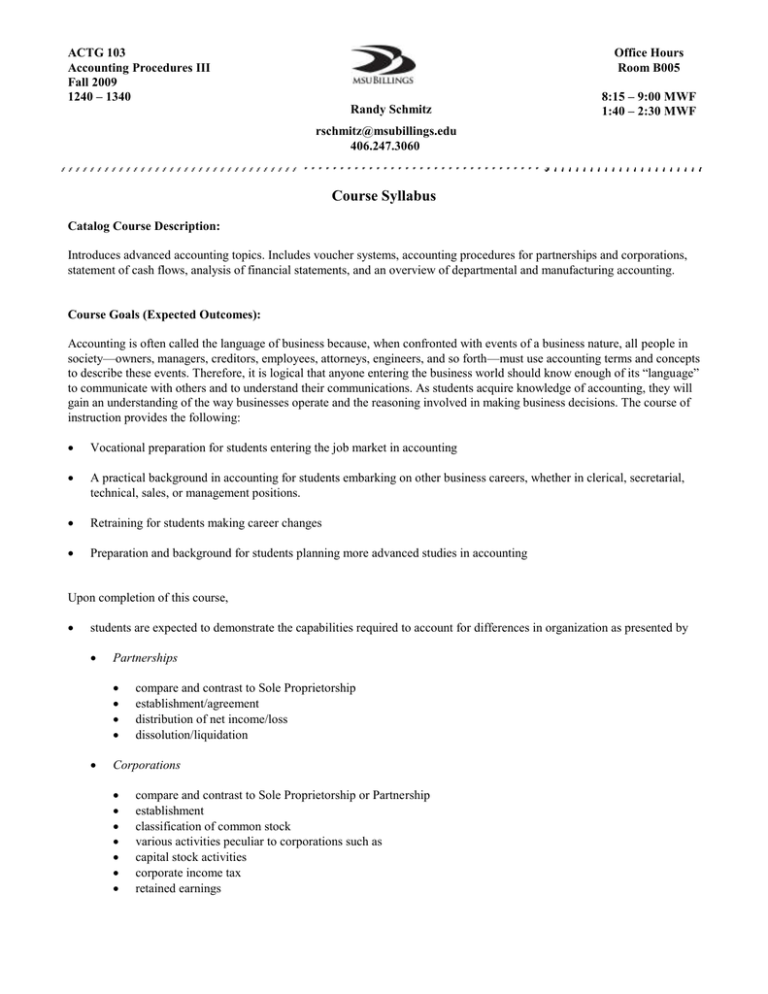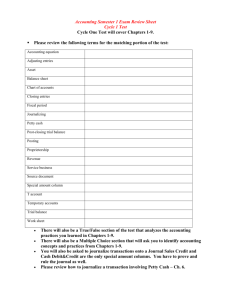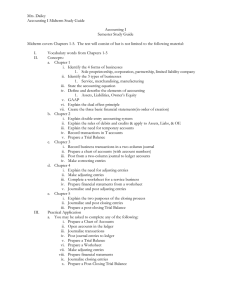Document 15532977
advertisement

ACTG 103 Accounting Procedures III Fall 2009 1240 – 1340 Office Hours Room B005 Randy Schmitz 8:15 – 9:00 MWF 1:40 – 2:30 MWF rschmitz@msubillings.edu 406.247.3060 Course Syllabus Catalog Course Description: Introduces advanced accounting topics. Includes voucher systems, accounting procedures for partnerships and corporations, statement of cash flows, analysis of financial statements, and an overview of departmental and manufacturing accounting. Course Goals (Expected Outcomes): Accounting is often called the language of business because, when confronted with events of a business nature, all people in society—owners, managers, creditors, employees, attorneys, engineers, and so forth—must use accounting terms and concepts to describe these events. Therefore, it is logical that anyone entering the business world should know enough of its “language” to communicate with others and to understand their communications. As students acquire knowledge of accounting, they will gain an understanding of the way businesses operate and the reasoning involved in making business decisions. The course of instruction provides the following: Vocational preparation for students entering the job market in accounting A practical background in accounting for students embarking on other business careers, whether in clerical, secretarial, technical, sales, or management positions. Retraining for students making career changes Preparation and background for students planning more advanced studies in accounting Upon completion of this course, students are expected to demonstrate the capabilities required to account for differences in organization as presented by Partnerships compare and contrast to Sole Proprietorship establishment/agreement distribution of net income/loss dissolution/liquidation Corporations compare and contrast to Sole Proprietorship or Partnership establishment classification of common stock various activities peculiar to corporations such as capital stock activities corporate income tax retained earnings dividends description and classification of long-term investments students are expected to demonstrate the capabilities required to interpret and explain the concepts relating to Cash Flow Comparative Financial Statements Departmental Accounting Manufacturing Accounting Course Objectives Outline (Competencies): I. Partnerships A. Define a partnership, and (1) list the main advantages and the main disadvantages of a partnership (2) journalize initial investments B. Provide for the division of net income and loss (1) on the basis of fractional shares (2) on the basis of ratio of capital investments (3) on the basis of salary and interest allowances C. Journalize the closing entries for a partnership D. Prepare a statement of partners' equity E. Journalize entries involving the sale of a partnership interest or withdrawal of a partner F. Journalize entries pertaining to the liquidation of a partnership involving the immediate sale of the assets for cash II. Corporations A. Define a corporation B. Name at least two advantages and two disadvantages of a corporation C. Journalize entries for the issuance of par-value stock D. Journalize entries for the issuance of no-par stock E. Journalize entries for the sale of stock on the subscription basis F. Prepare a classified balance sheet for a corporation, including Subscriptions Receivable, Organization Costs, Paid-in Capital, and Retained Earnings accounts III. Cash Flow A. Describe the statement of cash flow, and define cash and cash equivalents B. State the purpose of the statement of cash flows C. State the uses of the statement of cash flows by management, investors, and creditors D. Identify cash inflows and outflows as operating, investing, or financing activities E. Calculate amounts of cash inflows and outflows involving operating, investing, and financing activities F. Prepare a statement of cash flows using the direct method IV. Comparative Income Statements A. Prepare a comparative income statement and balance sheet involving horizontal analysis. B. Prepare a comparative income statement and balance sheet involving vertical analysis. C. Express income statement data in trend percentages. D. Compute (1) working capital (2) current ratio (3) quick ratio (4) accounts receivable turnover (5) merchandise inventory turnover (6) ratio of stockholders' equity to liabilities (7) ratio of the value of plant and equipment to long-term liabilities. E. Calculate (1) equity per share (2) rate of return on common stockholders' equity (3) earnings per share of common stock (4) price-earnings ratio. V. Departmental Accounting A. Compile a departmental income statement extended through Gross Profit. B. Compile a departmental work sheet. C. Compile a departmental income statement extended through Income from Operations. D. Apportion operating expenses among various operating departments. E. Compile a departmental income statement extended through departmental margin. VI. Manufacturing Accounting A. Prepare a statement of cost of goods manufactured. B. Complete a work sheet for a manufacturing enterprise and journalize closing entries. C. Define a job-order cost accounting system and make related entries. D. Define a process cost accounting system and make related entries. Specific Instructional Materials, References & Text List: College Accounting, 9th Edition, McQuaig, Douglas J. and Bille, Patricia A., Houghton-Mifflin, 2008 Working Papers to Accompany College Accounting, 9th Edition, McQuaig, Douglas J. and Bille, Patricia A., HoughtonMifflin, 2008 Outcomes Assessment and Grading Procedures: Homework is due at the beginning of the class period and is accepted on the due date only. Daily assignments that are collected are worth five points each when handed in complete and will be averaged into each student’s individual grade for the course. Application tests will be given after each of the units. Each test is worth 100 points and will be given at the scheduled time only. The final grade will consist of the average of the unit test scores and the homework grade. Satisfactory completion of this course requires consistent classroom attendance and active participation. Grading 92–100 82–91 70–81 60–69 Below 60 A B C D F Classroom Policy: Students’ rights and responsibilities, as well as the Code of Conduct are outlined in the Montana State University Billings Student Handbook. Students should be familiar with the rights and responsibilities of students in the Academic Community. Students with disabilities, whether physical, learning or psychological, who believe that they may need accommodations in this class are encouraged to contact Disability Support Services as soon as possible to ensure that such accommodations are implemented in a timely fashion. Please meet with DSS staff to verify your eligibility for any classroom accommodations and for academic assistance related to your disability. Disability Support Services is located in A030, COT, 247-3029. Cheating, plagiarism, and other acts of academic dishonesty are regarded as serious offenses. Instructors have the responsibility to submit, in a written report to the Associate Vice President of Student Life, any such incident that cannot be resolved between the instructor and student. Depending on the nature of the offense, serious penalties may be imposed, ranging from loss of points to expulsion from the class or college. Student rights and responsibilities can be located in the MSU-Billings Student Handbook. Instructors have the responsibility to set and maintain standards of classroom behavior appropriate to the discipline and method of teaching. Students may not engage in any activity which the instructor deems disruptive or counterproductive to the goals of the class. Students that have a concern regarding any inappropriate conduct should bring it to the attention of their instructor, advisor, or Department Chair immediately. Inappropriate conduct situations will be reviewed immediately. Cellular phones, pagers, CD or various media players, and similar devices can be a nuisance and are prohibited in the classroom and laboratory facilities. Turn them off before entering the classroom. Each use will result in a 20 point deduction from your final grade. Instructors have the right to remove offending students from class. Repetition of the offense may result in expulsion from the course. The use of a cell phone as a calculator is not acceptable. Children represent a disruptive element for the classroom. They also increase the risk of accidents occurring in the laboratory. For those reasons, children should not be brought to either the classroom or the laboratory Free tutoring services for students are available in the Academic Support Center at the COT, A035, Monday through Friday, 8 a.m. – 5 p.m. The Academic Support Center on the other campus is open from 8 a.m. – 8 p.m. Monday – Thursday, 8 a.m. – 5 p.m. Friday, and 9 a.m. – noon Saturday. Tutors specialize in math, writing, anatomy and physiology, and other specialty areas for specific majors. See http://www.msubillings.edu/asc/ for more information or call 247-3022 (COT) or 657-1641 (other campus). MSU Billings supports a drug free environment. Any student who demonstrates a pattern of behavior that suggests drug or alcohol abuse will be asked to leave class and must participate in a counseling program prior to continued attendance. Continued abuse may result in reprimand, probation, restriction, suspension or expulsion. Rev. September 2, 2009


